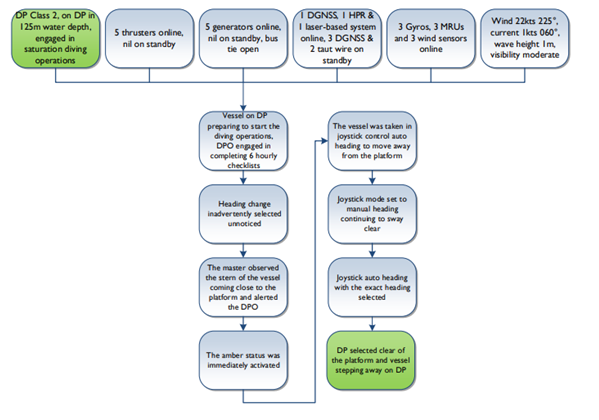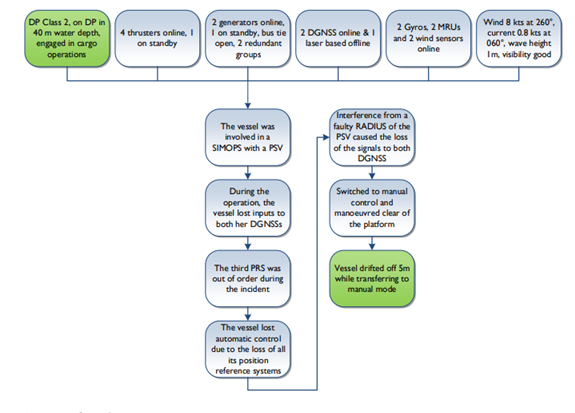Simultaneous activities on the bridge caused a DP Incident

Comments from the report:
The DPO, though experienced, was new to the vessel and the DP system. He had undergone familiarisation of the system but misinterpreted 30o heading increment as being a 30o/ min rate of turn. As the 6-hourly checklists were being completed, the vessel was making moves and deploying references. Multiple operations were initiated just prior to watch handover which could have been delayed by a few more minutes.
Considerations of the IMCA Marine DP Committee from the above event:
- Bridge resource management was not properly exercised. In principle, the second DPO should fill out the checklists and the DPO at the desk should concentrate on vessel position keeping only;
- The familiarisation process should be reviewed to be more robust to ensure new DPOs are completely familiar with the desk and functions;
- Reference should be made to IMCA M 117 “The training and experience of key DP Personnel;
- It should be noted that a 30o per minute rate of turn was considered to be far too high whilst engaged in diving operations.
2 Inadequate Position Reference Systems Caused DP Incident

Comments from the report:
It is mentioned in the report that task appropriate mode (TAM) and activity specific operating guidelines (ASOG) were in use, with the limitation identified for 2 DGNSS subject to common mode failure.
Considerations of the IMCA Marine DP Committee from the above event:
- Use of only 2 DGNSS was contrary to the MSc.1 / Circ. 1580 requirements. This meant the vessel was not set up in accordance with DP class 2 requirements of 3 position reference systems based on at least two different principles;
- Vessel sensors selection did not appear to comply with DP class 2 requirements, though this non-compliance was not a factor in the incident;
- Task appropriate mode was in place, indicating that a loss of position was acceptable. However, the incident indicates that an adequate risk assessment was not done and TAM and ASOG were not thoroughly reviewed prior to their approvals;
- When the vessel lost its automatic DP control due to the loss of all its PRSs, the position could have been maintained for a period of time using the DP mathematical model;
- The report states that interference from a faulty laser-based system on the PSV caused the loss of signals to both the DGNSSs. However, this could have been caused by interference of the differential correction signal receivers caused by shielding or reflection;
- Information on radio interference is provided in IMCA M 252 Guidance on Position Reference Systems and Sensors for DP Operations, Section 4.6 Operational Consideration Summary.
DP Event
Published: 3 December 2020
Download: IMCA DPE 04/20
Submit a Report
The following case studies and observations have been compiled from information received by IMCA. All vessel, client, and operational data has been removed from the narrative to ensure anonymity.
Case studies are not intended as guidance on the safe conduct of operations, but rather to assist vessel managers, DP operators and DP technical crew in appropriately determining how to safely conduct their own operations. Any queries should be directed to IMCA at [email protected]. Members and non-members alike are welcome to contact IMCA if they have experienced DP events which can be shared anonymously with the DP industry.
IMCA’s store terms and conditions (https://www.imca-int.com/legal-notices/terms/) apply to all downloads from IMCA’s website, including this document.
IMCA makes every effort to ensure the accuracy and reliability of the data contained in the documents it publishes, but IMCA shall not be liable for any guidance and/or recommendation and/or statement herein contained. The information contained in this document does not fulfil or replace any individual’s or Member's legal, regulatory or other duties or obligations in respect of their operations. Individuals and Members remain solely responsible for the safe, lawful and proper conduct of their operations.
